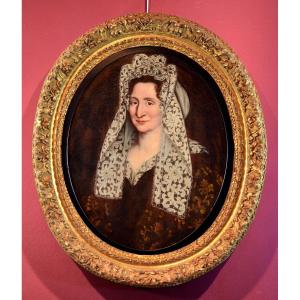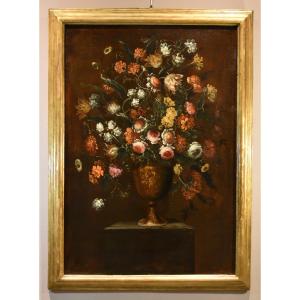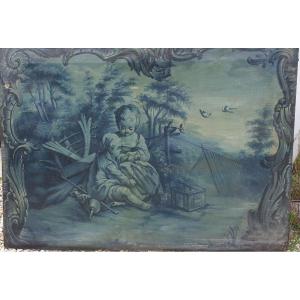workshop/attributable
Hercules and Onphale
Oil on canvas (109 x 80 cm. - Framed 126 x 97 cm.)
Full details (click HERE)
In the proposed beautiful work illustrating the myth of Hercules and Queen Onphale, we can admire the style characteristics typical of the early 17th-century Venetian school, and in particular, the rosy hues of the flesh close to the marked black outlines of the figures lead the work convincingly to the hand of Alessandro Varotari, known as il Padovanino (Padua 1588-Venice 1648).
The painting, which could easily be placed around the fourth decade of the seventeenth century, still adheres to the tradition of late-sixteenth-century Venetian painting, in a phase of the artist's reworking of Titianesque modes.
His formal elegance and painterly softness are enhanced in mythological scenes such as ours, characterized by sensual and classical nudes. In many ways, these depictions are anticipatory of those that Sebastiano Ricci and Giovanni Antonio Pellegrini would produce a century later.
The painter constructs the scene with great theatricality: the hero's mighty body lies on the ground surrendered, unarmed, while the beautiful queen, delicately crowned with pearls, expresses all her supremacy as she stands displaying the club yielded to her by Hercules.
The intriguing iconography is based on an episode from Greek mythology (Apollodorus, Library 2.6,3), in which Hercules, the most famous hero of all time and a veteran of his legendary twelve labors, was forced at the behest of the oracle of Delphi to become the personal slave of the queen of Lydia, Onphale.
From being a mere servant, Hercules would later become her lover, thus submitting to the magic of Eros, whom we see depicted between the two: in the painting, Hercules' submission is underscored by the fact that the hero, seated on the ground, handed the queen his club, which had become the symbolic attribute of his power, while he handed Eros the golden apples of the Hesperides.
Padovanino's late Mannerism is expressed in the articulated relationship of tension of the bodies of all the characters involved and we can find it in numerous works by the author, including the Orpheus and Eurydice of the Galleria dell'Accademia in Venice (1), the Rape of Deianira of the John and Mable Ringling Museum of Art in Florida (2), and finally the Venus and Adonis of Colnaghi in London (3)
1- https://catalogo.fondazionezeri.unibo.it/scheda/opera/59706/
2- https://catalogo.fondazionezeri.unibo.it/scheda/opera/59734/
3- https://catalogo.fondazionezeri.unibo.it/scheda/opera/59733/
ADDITIONAL INFORMATION:
The work sold is completed by a nice antique frame and comes with a certificate of authenticity and guarantee.
We take care of and organize the transportation of the purchased works, both for Italy and abroad, through professional and insured carriers.
You can also see the painting in the gallery in Riva del Garda, we will be happy to welcome you to show you our collection of works.
Please contact us, without obligation, for any additional information.
Also follow us on :
INSTAGRAM https://www.instagram.com/galleriacastelbarco/?hl=it
FACEBOOK https://www.facebook.com/galleriacastelbarco


















































 Le Magazine de PROANTIC
Le Magazine de PROANTIC TRÉSORS Magazine
TRÉSORS Magazine Rivista Artiquariato
Rivista Artiquariato